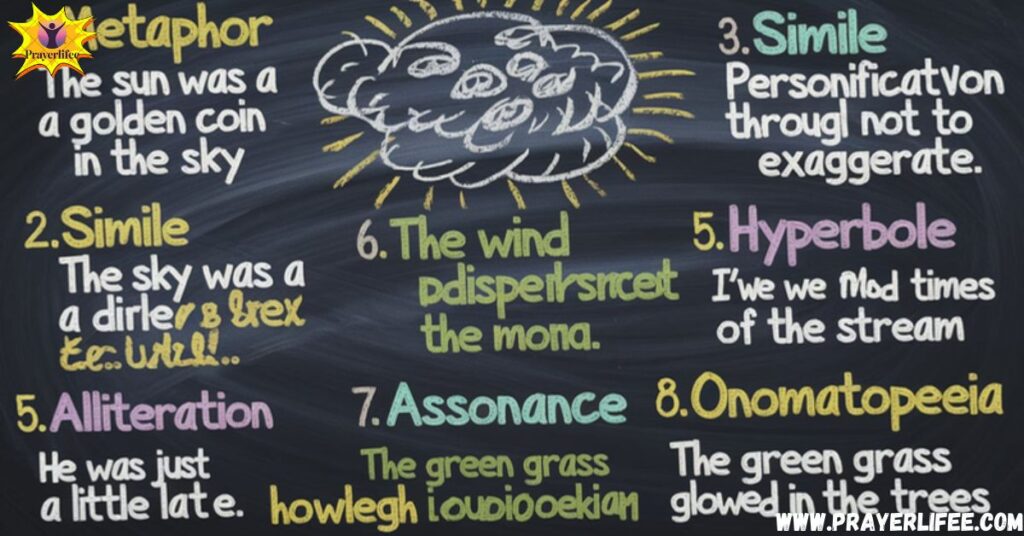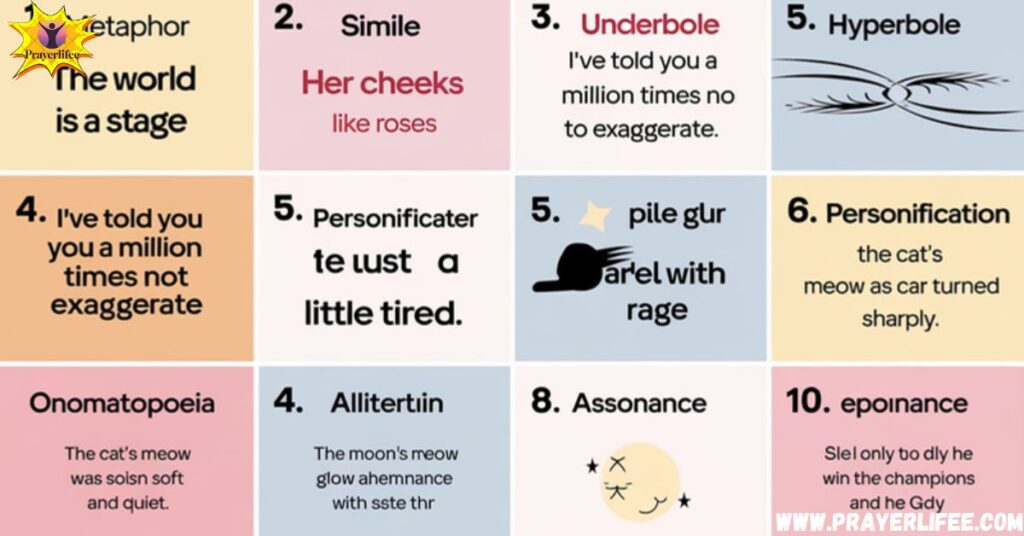Examples of Figures Language is more than just a tool for communication; it’s an art. Figures of speech are like the brushstrokes that turn simple conversations into powerful expressions. Whether you’re writing a poem, giving a speech, or just chatting with friends, figures of speech make your language come alive.
They help you paint vivid pictures in the minds of your audience, add humor, or emphasize important points. In this article, we’ll explore 50 examples of figures of speech and how they enhance communication, writing, and storytelling.
The Power of Figurative Language
When we use figurative language techniques, we go beyond the literal meaning of words. Instead of saying something straightforward, figures of speech give us the freedom to express ourselves creatively and emotionally. They can turn simple descriptions into something that captures the imagination. For instance, when you say “Life is a rollercoaster,” you’re not just talking about a theme park ride. You’re expressing the ups and downs of life in a way that everyone can relate to.
Figurative expressions allow you to create visual imagery in writing, making your words more memorable. They also give emotional depth to your sentences, making your ideas stick with your audience. Understanding figures of speech is crucial for anyone looking to master language and communication—from students to seasoned writers.
So let’s dive into the world of rhetorical figures and explore how you can use them to enhance your own writing and speaking skills.
Metaphors: Painting Pictures with Words

One of the most powerful literary devices is the metaphor. A metaphor is a direct comparison between two things that are not alike, but share some common characteristic. For example, when you say “Her voice is music to my ears,” you’re comparing her voice to music, even though they are not literally the same. Metaphors allow you to express complex ideas in simple ways by creating powerful visual comparisons in language.
In metaphors in literature, authors often use them to convey emotions and themes without explicitly stating them. A metaphor can simplify an abstract idea, like saying “Time is money.” Here, the metaphor helps people understand the value of time in a way that is immediately clear. If you’re crafting a speech or writing a poem, using metaphors effectively can make your message more engaging and memorable.
Similes: The Art of Comparison
A simile is a figure of speech that makes comparisons using the words “like” or “as”. It’s a softer, more direct way to compare two things. For instance, “She was as busy as a bee” uses a simile to describe someone’s activity level by comparing it to the well-known behavior of a bee. This technique helps your audience understand a concept more clearly by drawing on something they already know.
Similes and comparisons are often used in storytelling to make characters and situations come to life. Think of the popular simile “as brave as a lion.” It’s a simple comparison, but it conveys courage in a vivid way. When you use similes, it’s important to pick comparisons that make sense in the context. Similes in writing help create descriptive language and are especially useful for vivid descriptions in writing.
Personification: Bringing Objects to Life
Personification is when you give human qualities to non-human things, animals, or ideas. This figure of speech brings your writing to life by making objects feel relatable. For example, saying “The wind whispered through the trees” gives the wind the human ability to whisper, which makes the scene more magical and mysterious.
In personification in poetry, poets often use this technique to convey emotions or themes more powerfully. When you say, “The sun smiled down on us,” you’re not just describing the weather. You’re evoking a feeling of warmth and positivity. This is why personification is a popular tool for emotional impact and creating strong imagery in both creative writing and everyday language.
Hyperbole: Exaggeration for Effect
Sometimes, when we want to emphasize something, we use hyperbole. This is a figure of speech that involves exaggeration to make a point. For example, “I’ve told you a million times” is an exaggeration, but it effectively emphasizes frustration or urgency. Hyperbole helps you communicate with persuasive language and adds humor to conversations or writing.
In hyperbole examples, you often see over-the-top statements like “I’m so hungry I could eat a horse” or “He’s older than dirt.” While these aren’t meant to be taken literally, they enhance storytelling and convey strong emotions. Hyperbole is particularly effective in humorous figures of speech, making the audience laugh or react to the outrageousness of the statement.
Read More: 500+ Dirty Team Names That Will Shock and Amuse Your Crew
Understatement: The Power of Saying Less
Where hyperbole exaggerates, understatement plays it down. An understatement is when something is presented as less significant or serious than it actually is. For instance, if someone says, “It’s just a scratch” after a big accident, they’re minimizing the seriousness of the situation.
In rhetoric, understatement is often used to create irony or humor. It can make the audience think more deeply about the situation, as in “I’m a little tired” after running a marathon. Understatement in rhetoric can be a tool for both irony and self-deprecation. In some cases, it can even help reduce tension in serious discussions.
Oxymoron: Contradictions that Make Sense
An oxymoron is when two contradictory terms are put together, but they make sense when used creatively. “Deafening silence” is a classic example. Silence can’t literally be deafening, but the phrase evokes a powerful image of an intense quiet. This kind of contradiction can create drama, surprise, or humor.
In literature and everyday speech, oxymoron meaning can reflect complex ideas or paradoxes. For example, “bittersweet” captures the feeling of something that’s both happy and sad at the same time. By using oxymorons, you add depth to your descriptions, creating tension or humor in the process.
Alliteration: The Music of Repeated Sounds
Alliteration involves repeating the same sound at the beginning of several words in a sentence or phrase. It’s often used in creative writing techniques to make the language more musical and memorable. For instance, “Peter Piper picked a peck of pickled peppers” is an alliterative phrase that creates a rhythm and sticks in the reader’s or listener’s mind.
In alliteration in writing, this technique is used in tongue twisters, slogans, and poetry to make language more playful and engaging. Brands like Coca-Cola and PayPal use alliteration in their names because it makes them easy to remember. When used correctly, alliteration can make your writing feel more fluid and enjoyable.
Onomatopoeia: Words that Sound Like Their Meaning

Onomatopoeia refers to words that imitate the sounds they describe, like “buzz,” “boom,” or “sizzle.” These words are sensory, evoking not just a mental image but also a sound that helps to bring your writing to life. Whether it’s the sound of a door slamming or the sizzle of bacon, onomatopoeia makes the reader or listener feel as if they’re experiencing the event themselves.
In onomatopoeia examples, writers use these words in comics, poems, and children’s books to add fun and engagement. The sound of the words helps to reinforce the scene or action, creating a vivid description that goes beyond simple narration.
Idioms: Phrases with Hidden Meanings
Idioms are phrases where the meaning doesn’t directly come from the words themselves. For example, “Break a leg” doesn’t literally mean to break a leg. It’s a way of wishing someone good luck. Similarly, “It’s raining cats and dogs” simply means that it’s raining heavily.
Common idiomatic expressions like these add color and personality to your language. They make conversations more interesting and help people connect in a cultural context. Cultural idioms often reflect values and humor specific to a region or country, like in the U.S., where idioms are often casual and playful.
Euphemism: Softening the Blow
When we want to talk about sensitive topics, we often use a euphemism. This is when we replace a harsh or direct word with something softer. For instance, instead of saying someone “died,” we might say they “passed away.” This makes the topic easier to discuss and less uncomfortable for the listener.
In euphemism in communication, this figure of speech is widely used in professional settings, politics, and media. For example, “downsizing” is often used instead of “layoffs” in the corporate world. Euphemisms help people navigate difficult conversations with more tact and sensitivity.
Synecdoche and Metonymy: Parts Representing Wholes

Synecdoche and metonymy are two figures of speech that simplify communication by using part of something to represent the whole, or vice versa. For example, saying “Wheels” to refer to a car is a synecdoche, and “The White House” to refer to the U.S. president is a metonymy.
Both figures of speech create shortcuts that make communication easier and more direct. In metonymy in literature, these expressions help convey deeper meanings or ideas by connecting parts with larger concepts. Synecdoche examples are common in everyday language and storytelling, making them essential tools for writers.
Irony: When Words Mean the Opposite
Irony is a figure of speech where words mean the opposite of what they seem to say. There are several types of irony, but one common example is dramatic irony, where the audience knows something the characters don’t. A simple example of irony in language is saying, “Great, another traffic jam” when you’re actually frustrated.
Understanding the types of irony—like situational and verbal irony—helps you better grasp how language can be used to create humor, tension, or surprise. Dramatic irony examples in movies and plays often create suspense and deepen the audience’s emotional connection to the story.
Conclusion: Mastering the Art of Figurative Language
Mastering the use of figures of speech in daily life can significantly enhance your ability to communicate. Whether you’re using hyperbole to emphasize a point, similes and comparisons to describe an experience, or irony to make your audience think, these tools add color, emotion, and meaning to your words. By understanding and practicing these figurative language techniques, you can improve your writing, speaking, and overall communication skills.
By exploring and experimenting with figurative language in speeches, literary devices, and descriptive language, you’ll find new ways to express your ideas. Start incorporating these expressive language tools into your everyday conversations, and you’ll soon see the power of figures of speech in action.

